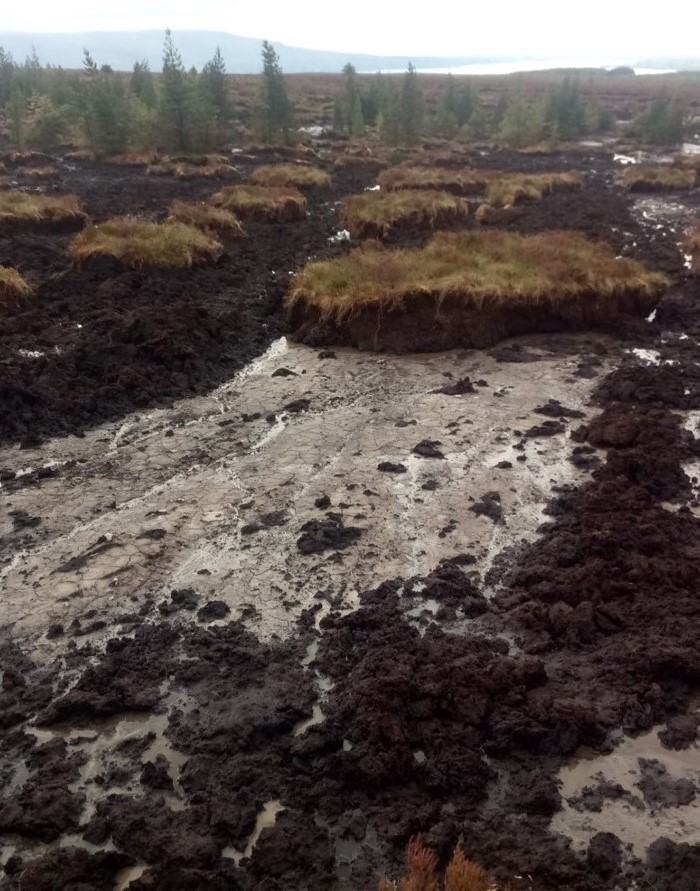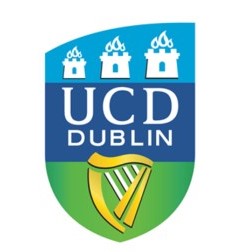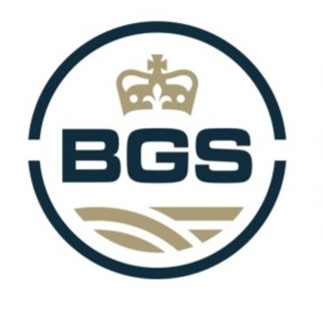Peatland Hydrogeological Assessment for Slope Stability Evaluation (PHASSE)
Background
Peat covers over one fifth of Ireland, yet groundwater flow through it remains poorly understood. This knowledge gap limits our confidence in quantifying bogs respond to loading and artificial drainage, such as that experienced during installation of wind energy facilities, and how these activities can influence landslide risk.
Recently completed research at Queen’s University Belfast has shown that groundwater can flow through peat considerably faster than previously assumed. This shows potential for the application of alternative methods to investigate the hydrogeology of bogs.
Research Aims
The Geological Survey of Ireland -funded Peatland Hydrogeological Assessment for Slope Stability Evaluation (PHASSE) aims to evaluate the reliability of techniques for the in-situ quantification of peat hydrogeological properties. This information provides key information about how peat can influence groundwater flow, pore water pressure and slope stability.
PHASSE is a short proof-of-concept project that combines established artificial tracer testing techniques and geophysical methods to track groundwater flow at an existing blanket bog research site.
Investigations will employ contrasts in tracer and bog groundwater electrical conductivity to track flow trajectories using geoelectrical techniques. Monitoring flow paths and hydraulic gradients provides a means of independently determining peat hydrogeological properties for comparison with more widely used methods.
A more accurate understanding of these properties is essential for further advancing current understanding of peat slope failures, and how these are affected by activities such as installation of drains, the construction of access roads and excavations. Recent years has witnessed these features becoming more common across Irish Uplands, and linked to landslides and bog bursts.
Blanket Bog Hydrogeological Properties
Hydraulic Conductivity
| Blanket Bog | K (m/day | Location | Comments | ||||
| Source | Year | Type of measurments | Max | Mean | Min | ||
| Baird,et al. | 2016 | Piezometer tests | >86.4 | <0.0864 | Britain | Raised Bog | |
| Ballard,et al. | 2011 | Modelling | 4.00E+00 | 1.00E-01 | Britain | Acrotelm | |
| 5.00E-02 | 1.00E-03 | Catotelm | |||||
| Beckwith,et al. | 2003 | Modified Cube | 1.63E+01 | 1.00E-03 | Britain | Raised bog | |
| Boelter | 1965 | Field and Lab | 8.64E+00 | 8.64E-02 | Britain | Diverse peat types | |
| Branham and Strack | 2014 | Lab cube measurements | 4.06E+01 | 9.32E-04 | Canada | Kh -Overall K lower at margin than in centre along transect | |
| Burke, | 1978 | Lab measurements -constant head | 1.63E+01 | 1.00E-03 | Ireland | Disturbed peat. Changes in K due to land use change | |
| Clay,et al. | 2009 | Piezometer tests | 1.21E+00 | 1.12E-05 | Britain | Klower from buring | |
| Cunliffe et al. | 2013 | Cube testing in lab | 1.19E+03 | 2.62E-03 | Britain | Blanket Peat approaching a pipe. Kh-with directional variability | |
| 1.81E+02 | 1.54E-03 | Kv | |||||
| Flynn,et al. | 2022 | Piezometer | 1.66E-03 | 9.32E-04 | Ireland | In catotelm in intact and drained settings | |
| Foteu et al. | 2018 | Constant head in lab | 1.34E+00 | 8.64E-05 | 8.64E-02 | Ireland | Focusing on slope failure-after failure |
| Galvin and Hanrahan | 1967 | Pumping | 9.50E-03 | 2.94E-03 | Ireland | K decline with depth | |
| Galvin, | 1976 | Lab Constant Head, Auger Hole | 1.30E-02 | 6.00E-03 | Ireland | Early reported hydraulic conductivity data | |
| Hoag and Price | 1997 | Tracer Testing | 8.64E+02 | Canada | Acrotelm | ||
| Hobbs, | 1986 | Piezometer and Lab | 8.64E-02 | 8.64E-03 | Britain | Cotton Sedge Peat H3 to H6 | |
| Holden,et al. | 2003 | Piezometer | 5.06E-02 | 4.32E-04 | Britain | Used rigid and compressible soil theory. Compressible soil theoryK up to 5 times less. Large lateral variability | |
| Holden,et al. | 2009 | Tension disk infiltrometer | Most of flow in small volume of peat. Large decline in effective porosity with depth. £ orders of magnitude within 20cm depth | ||||
| Holden,et al. | 2018 | Piezometer tests | 5.50E-01 | Britain | At pool edges | ||
| Ingram,et al. | 1967 | Piezometer test | 1.73E-04 | 5.18E-05 | Britain | ||
| Lewis,et al. | 2012 | Cube testing in lab | 2.08E+00 | 1.04E-02 | Ireland | Kh -Overall K lower at margin than in centre along transect | |
| 2012 | 5.68E-03 | 6.39E-04 | Kv | ||||
| Mulqueen,et al. | 1997 | Augur hole and piezometer testing | 3.20E-01 | 1.20E-01 | Ireland | Augur hole | |
| 1997 | 4.00E-02 | 5.50E-01 | Ireland | Piezometer | |||
| Rycroft,et al. | 1975 | Piezometer tests | 1.53E+00 | 4.32E-03 | Britain | Notice of flexibility in medium | |
| Wallage and Holden | 2011 | Tension infiltrometers | 1.35E+00 | 8.53E-01 | Raised water table leading to elevated Ksat. Undisturbed blanket peat | ||
| 1.73E+00 | 3.37E-02 | 6.05E-03 |
| Other Peat Types | K (m/day | Location | Comments | ||||
| Source | Year | Type of measurments | Max | Mean | Min | ||
| Baden and Egglesmann, | 1961 | Augur hole | 4.15E-01 | Netherlands? | Brown Moss | ||
| Baird,et al. | 1997 | Lab (tension Disk) | 1.32E-01 | 1.33E-02 | Britain | Fen peats-unsaturated zone with log normal K. Macro pores important . Values depend on measurement technique | |
| Baird,et al. | 2008 | Piezometer test | 2.89E+00 | 7.78E-02 | Britain | Raised Bog | |
| Boelter, | 1968 | Piezometer | 3.29E+01 | 1.20E-01 | USA | Acrtotelm -moderately decomposed Sphagnum | |
| Bourgault,et al. | 2018 | Lab-Cubes | 1.21E+03 | 5.79E+01 | 2.59E-03 | Canada | Signfiicnat correlation with Sy |
| Bromley,et al. | 2004 | Lab, Augur hole and piezometer tests | 6.91E-01 | 1.13E-02 | Britain | Augur Hole | |
| 9.50E+00 | 5.96E+00 | Double Ditch | |||||
| 3.46E+00 | 3.46E-01 | Lab | |||||
| 6.91E+01 | 8.64E+00 | Single ditch | |||||
| Chason and Siegel | 1986 | Piezometer test | 4.84E+00 | 2.16E-01 | USA | Anisotropy highly variable, humified peat can transmit more warter than previously suspected | |
| Clymo,et al. | 2004 | Piezometer test | 1.04E+00 | 8.64E-02 | Britain | Raised bog-exponential decline with depth | |
| Dai and Sparling | 1973 | Piezomter test | 2.30E+00 | 2.88E-01 | Canada | Study completed over small areea | |
| Gafni,and | 1986 | Dilution gauging | 2.03E+02 | 6.91E+00 | USA | Highest at ground surface | |
| Glaser,et al. | 2021 | Pumping Test | 8.64E+01 | 8.64E+00 | USA | Bog Lawn -Biogenic gas contributions | |
| Howson,et al. | 2023 | Piezometer tests, Minidisc infilltrometers | 1.90E+00 | 3.07E-01 | 4.32E-03 | Britain | Raised |
| Irwin,et al. | 1968 | Piezometer Test, augur hole, two well technique | 4.92E-01 | Canda | |||
| Kennedy,and | 2005 | Piezometer Testing | 8.64E+00 | 8.64E-03 | Canada | Cutover area and change in K due to compressibility | |
| Lapen,et al. | 2005 | Modelling | 1.21E+02 | 6.39E+00 | Canada | Raised bog | |
| Malmstrom, | 1925 | Lab | 6.91E+00 | 1.47E-01 | Sweden | Kh and Kv comparable. | |
| Menberu,et al. | 2021 | Diverse field and diverse lab | 3.72E+01 | 3.02E+00 | 2.04E-03 | Finland | Diverse data sources showing impact of land use change on peat, incluing K decline |
| Morris,et al. | 2015 | Modified Cube | 2.69E-02 | 6.00E-05 | 7.16E-06 | Britain | Used harmonic mean since few v.permeable samples |
| Morris,et al. | 2019 | Lab based -Cube | 8.45E+02 | 4.32E-03 | Britain | Kh | |
| 6.29E+02 | 2.59E-03 | Kv | |||||
| Regan,et al. | 2019 | Piezometer tests | 2.20E-03 | Ireland | Raised Bog -low heads imposed | ||
| 2.90E-03 | Deep peat | ||||||
| 1.12E-01 | Shallow peat | ||||||
| Regan,et al. | 2020 | Piezometer Tests | 6.73E-01 | 1.15E-02 | 1.00E-05 | Ireland | Mid Peat |
| 2.12E-01 | 6.31E-06 | 8.99E-06 | Basal | ||||
| Rosa and Lacroque | 2008 | Tracer, Lab and slug tests | HVORSLEV Detail | ||||
| 2.09E+00 | 1.03E-02 | Canada | Lab -highly variable anisoptropy 0.1-9.45 | ||||
| 8.64E+03 | 9.94E+02 | 2.59E+02 | Acrotelm | ||||
| 6.00E+00 | 9.94E-03 | Slug | |||||
| Rycroft,et al. | 1975 | Piezometer Tests | 2.42E+02 | 8.64E-04 | |||
| Sarasto | 1961 | Lab test? | 7.69E+01 | 2.33E-01 | Finland | Kh Sphagnum -lab | |
| 2.33E+01 | 5.36E-01 | Finland | Kh Carex - Lab | ||||
| 3.89E+01 | 2.33E-01 | Kv Sphagnum -lab | |||||
| 2.42E+01 | 3.89E-01 | K Carex - Lab | |||||
| Sturges,et al. | 1968 | Piezometer Test | 2.42E-04 | 1.56E-04 | USA | Well decomposed peat | |
| Surridge,et al. | 2005 | Lab and Field with Fen peat | Britain | Withdrawl (Rising Head) better | |||
| Weiland,et al. | 2024 | Piezometer Testing, KSAT apparatus | 6.91E+03 | 1.73E+00 | Canada | Shallow peat. Values estimated from graphs |
| Specific Yield / Drainable Porosity | |||
| Study reference | Measurement method | Location | Reported Sy / Drainable Porosity |
| Ahmad et al., 2021 | Water Table Change | Malaysia | 0.229 – 0.284 |
| Baird et al. (2024) | Drainage of Lab cores | Britain | 0.16-.62 |
| Boelter 1964, 1968, 1977 | Gravity drainage | Britain | 0.08 – 0.86 |
| Bourgault et al., 2017, 2018 | Water Table Change, gravity drainage on sub-samples, and drain down and refill experiment on peat monoliths | Canada | 0.01 – 0.99 |
| Carrer et al., 2015 | Gravity drainage on sub-samples | Canada | 0.08 – 0.60 |
| Cassidy 2018 | Minilysimeters | Ireland | 0.2-0.67 |
| Cobb and Harvey, 2019 | Water Table Change | Diverse | 0.2 – 0.69 |
| Dettmann and Bechtold, 2016 | Water Table Change | Diverse (European) | 0 – 0.9 |
| Galvin (1975) | Gravity Drainage | Ireland | 0.08-0.38 |
| Gardner and Gaines, 2008 | Water Table Change | USA | 0.08 – 0.12 |
| Grover and Baldock, 2013 | Drainage under pressure on sub-samples | Australia | 0.1 – 0.82 |
| Holden et al., 2018 | Water Table Change | Britain | 0.22 |
| Howson et al., 2023 | Gravity drainage on sub-samples | Britain | 0.0033 – 0.6093 |
| Ismali et al., 2021 | Water Table Change | Indonesia | 0.05 – 0.30 |
| Läpikivi et al., 2025 | Water Table Change | Finland | 0..08-0.19 |
| Li et al., 2019 | Gravity drainage on sub-samples | Diverse, Germany | 0.02 – 0.05 |
| McCarter and Price, 2015 | Drain down and refill experiment on peat monoliths | Canada | 0.01 – 0.41 |
| McCarter and Price, 2017 | Gravity drainage on sub-samples | Canada | 0.1 – 0.3 |
| Menberu et al., 2018 | Water Table Change | Finland | 0.13 – 0.50 |
| Menberu et al., 2021 | Gravity drainage | Finland | 0.11-0.4 |
| Mustamo et al., 2016 | Water Table Change | Finland | 0.067 – 0.47 |
| Price 1996 | Gravity drainage on sub-samples | Canada | 0.04 – 0.55 |
| Price and Schlotzhauer, 1999 | Water Table Change | Canada | 0.48 |
| Price, 1992 | Gravity drainage on peat monoliths | Canada | 0.1 – 0.5 |
| Rosa and Larocque, 2008 | Gravity drainage on peat monoliths | Canada | 0.23 |
| Roulet and Woo, 1986 | Gravity drainage | Canada | 0.057 |
| Schouwenaars, 1993 | Gravity drainage on peat monoliths | Netherlands | 0.05 – 0.34 |
| Schut and Westbrook, 2022 | Water Table Change | Canada | 0.02 – 0.88 |
| Sullivan et al., 2011 | Gravity drainage on peat cores and Water Table Change | USA | 0.01 – 0.40 |
| Thompson and Waddington, 2013 | Drainage under pressure on sub-samples | Canada | 0 – 0.8 |
| Thompson et al., 2014 | Drainage under pressure on sub-samples | Canada | 0.21 – 0.50 |
| Van Seters and Price, 2002 | Gravity drainage on sub-samples | Canada | 0.06 – 0.14 |
| Watras et al., 2017 | Water Table Change | USA | 0.3 ->1? (Estimated from graph) |
| Weiland et al. 2024 | Gravity drainage on sub-samples | Canada | 0.2-0.4 |
| Wilkinson et al., 2019 | Drainage under pressure on sub-samples | Canada | 0.05 – 0.73 |
| Worrall et al. (2015) | Modelling | Britain | .01-0.77 |
A short duration tripartite research partnership between Queen's University Belfast, University College Dublin and the British Geological Survey. PHASSE is funded through the Geological Survey of Ireland's 2024 Short Calls Research Programme. The project will run until September 2025.
Further support is provided by Northern Ireland Water (NI Water SCAMP Programme) and Northern Ireland Department of Agriculture, Environment and Rural Affairs (DAERA).
PHASSE is a tripartite research partnership with collaborators from Queen's University Belfast (QUB), University College Dublin (UCD) and the British Geological Survey (BGS):
#6 Clean water and sanitation
#9 Industry, innovation and infrastructure
#12 Responsible consumption and production
#13 Climate action
#15 Life on land
#17 Partnerships for the goals





